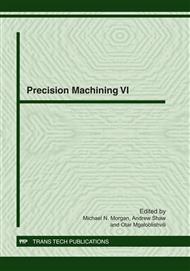p.50
p.55
p.61
p.67
p.75
p.80
p.86
p.92
p.98
Tool Coatings with the Effect of Adaptation to Cutting Conditions
Abstract:
The objective of the present work is to study tribological properties of multilayered wear resistant coatings on the cutting tools. Two types of coatings (TiAl)N were studied: normal monolayer coating and improved coating. The tests were conducted with cooling, and without it. During high speed machining an intensive tribo-oxidation of tool surface occurs. Formation of aluminum oxide films on the surface of cutting tool significantly changes the heat flow and heat dissipation into the chip. Conditions of the chips formation (chip thickness ratio and the shear plane angle) and the coefficient of friction on the rake face of the cutting tool have been measured during the cutting process. The results demonstrated significant improvement of tribological parameters for the cutting tools with filtered coatings.
Info:
Periodical:
Pages:
75-79
Citation:
Online since:
December 2011
Authors:
Price:
Сopyright:
© 2012 Trans Tech Publications Ltd. All Rights Reserved
Share:
Citation:


